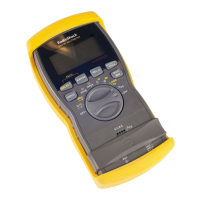21
Making Measurements
2.
Press
SELECT
once to set the meter to
measure AC current (
∼
∼∼
∼
appears). Otherwise,
repeatedly press
SELECT
to set the meter to
measure DC current (
∼
∼∼
∼
disappears).
3. Remove the power from the circuit under test
and discharge all capacitors.
4. Plug the black test lead into
–COM and the red
test lead into the appropriate jack.
5. Connect the meter’s test leads in series with
the circuit.
6. Apply power and read the current value. If the
measurement is less than 400mA and the red
test lead is connected to
+10A MAX, remove
power from the circuit.
If your measurement exceeds the selected
range,
Eý<
Eý<Eý<
Eý< appears until the measured voltage
or current is reduced to a value below the
selected range.
7.
Move the red test lead to
+ V.mA.
Ω
ΩΩ
Ω
.
8.
Rotate the function selector to
/
µ
µµ
µ
A/A
ý
ýý
ý
or
/
mA/A
depending on the value you measured in
Step 6.
9. Reapply power to the circuit.
If you are measuring DC current and the current’s
polarity is negative,
–
appears before the value.
/'#574+0)"4'5+56#0%'
The resistance measuring circuit in your meter
compares the voltage gained through a known
resistance (internal) with the voltage developed
across an unknown resistance.
Rý
.
..
.
1. Remove all power from the circuit under test
and discharge all capacitors.
.
"%#76+10"
.
Measuring DC/AC
Current
(continued)
• If you do not know the
amount of current in the
circuit you are
measuring, always
connect the red test lead
to
+10A MAX
.
Measuring Resistance
Your meter has a circuit to
protect the resistance range
from over-voltage.
However, to avoid
accidentally exceeding the
protection circuit’s rating
and to ensure a correct
measurement, never
connect the test leads to a
source of voltage while the
function selector is set to
•
.
ý
R
"9#40+0)
ý
R
"
Be sure the circuit under
test has all power removed
and any associated
capacitors are fully
discharged before you
make a resistance
measurement.
22-812.fm Page 21 Monday, April 8, 2002 1:32 PM

